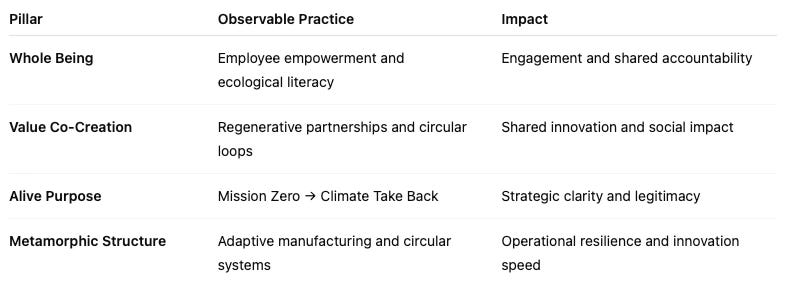Interface Inc. - Case Study
From “Mission Zero” to “Climate Take Back”: A Manufacturing Organisation Becoming a Living System
Context and Overview
Interface Inc., founded in 1973 by Ray Anderson, began as a traditional carpet tile manufacturer in Atlanta, USA. By the mid-1990s, Interface was one of the world’s largest flooring producers — but also a major industrial polluter.
A personal transformation by its founder in 1994 (sparked by reading Paul Hawken’s The Ecology of Commerce) led to a radical reorientation of the company: from linear, extractive production to regenerative business design.
Over the next three decades, Interface evolved from a manufacturer to a living, purpose-driven ecosystem, pioneering circularity, sustainable design, and purpose governance — an exemplar of the Alive Organisation paradigm in the industrial economy.
1. Whole Being – A Culture of Purposeful Work
Interface’s internal culture places deep emphasis on meaning, personal responsibility, and stewardship. Ray Anderson referred to sustainability not as a compliance requirement but as a moral awakening.
Key practices include:
Employee Sustainability Education: Every employee is trained to understand the ecological and social impact of their role.
Empowerment Programs: Frontline workers encouraged to propose and lead process improvements in waste, energy, and resource use.
Cross-Functional Learning Labs: Teams collaborate across functions to redesign processes for lower environmental impact.
Authentic Leadership Development: Leaders are trained to balance performance, ethics, and regeneration in daily decisions.
Interface’s people system fosters psychological ownership — where each individual connects their daily work with the wellbeing of the planet.
2. Value Co-Creation – Regeneration Through Collaboration
Interface’s innovation model redefines value creation as a network of co-responsibility across the entire value chain. Core examples of co-creation:
Supplier Partnerships: Interface’s Net-Works program collaborates with coastal communities to collect discarded fishing nets — turning waste into raw material while providing livelihoods.
Customer Engagement: Clients participate in circular programs where used flooring is collected, recycled, and returned as new products.
Industry Collaboration: Interface openly shares learnings with competitors and suppliers to accelerate industry-wide transformation.
Design Partnerships: Collaboration with biomimicry experts and designers to emulate natural ecosystems in product design (e.g., Entropy® Carpet Tiles).
Through these practices, Interface transformed the traditional supplier–manufacturer–customer chain into a living ecosystem — a hallmark of Value Co-Creation Practices.
3. Alive Purpose – “Mission Zero” and “Climate Take Back”
In 1994, Interface declared Mission Zero — a bold commitment to eliminate all negative environmental impacts by 2020. It achieved this goal in major categories: 96% renewable energy use, 89% reduction in carbon footprint, and closed-loop recycling across core operations.
In 2016, Interface evolved its purpose further into Climate Take Back:
“To run our business in a way that reverses global warming.”
This represents a clear Superior Purpose — the organisation’s reason for existing is to serve the wellbeing of the planet itself.
Purpose activation mechanisms:
Sustainability Strategy Integrated into P&L: Environmental metrics directly tied to financial reporting.
R&D Alignment: Innovation pipelines prioritise regenerative materials and carbon-negative processes.
Purpose Review Cycles: Annual reviews of sustainability progress tied to leadership KPIs.
Public Foresight and Advocacy: Interface participates in policy dialogue on climate and regenerative industry standards.
Purpose is not a brand element but a strategic operating principle, driving all organisational decisions and innovation.
4. Metamorphic Structure – Redesigning the Industrial Model
Interface restructured its operating system to align with regenerative purpose and adaptive learning. Structural attributes are:
Decentralised Manufacturing Cells: Local plants empowered to adapt sustainability practices to regional contexts.
Circular Supply Chains: Design, production, collection, and reuse integrated in closed feedback loops.
Innovation Ecosystems: External partnerships with universities, materials scientists, and community organisations.
Transparent Performance Platforms: Real-time dashboards for tracking energy use, waste, and emissions.
This structure enables Interface to sense, adapt, and learn continuously, mirroring the principles of natural ecosystems. It is a physical manifestation of Metamorphic Structure Practices — form following living purpose.
Governance and Decision Flow
Governance at Interface embeds purpose directly into accountability structures:
Board-Level Sustainability Oversight: Sustainability integrated into fiduciary governance.
Purpose Councils: Cross-functional groups responsible for progress on Mission Zero and Climate Take Back.
Transparency Standards: Public sustainability reporting with full data visibility (Scope 1–3 emissions, supply chain impacts).
Performance Integration: Executive bonuses tied to environmental and social metrics.
This ensures alignment between strategy, ethics, and execution, making purpose enforceable through governance, not just aspirational.
Systemic Integration
Interface exhibits strong coherence across all four pillars:
Interface’s aliveness is systemic — each pillar reinforces the others, creating a resilient organisational ecosystem.
Lessons for Other Organisations
Purpose can originate from moral reflection – Transformation begins with leadership consciousness and a shift in worldview.
Integrate purpose into financial and operational systems – Make impact measurable, auditable, and tied to business incentives.
Co-create value through ecosystems – Engage communities, suppliers, and customers in shared regeneration.
Design structures to mimic life – Enable feedback, diversity, and renewal like natural systems.
Lead with transparency – Accountability drives credibility and collective trust.
Interface’s journey proves that regeneration is not only possible but commercially sustainable when aligned with living purpose.
Conclusion
Interface Inc. is a living enterprise — a manufacturer that redefined business success as ecological and societal contribution. It demonstrates that industrial systems can become regenerative systems — guided by clear purpose, distributed responsibility, and structural adaptability.
Through its evolution from Mission Zero to Climate Take Back, Interface shows that purpose can evolve just as living systems do — expanding from doing less harm to actively healing the world it touches.
“Business is the only institution large enough, and pervasive enough, to lead humankind out of this mess.”
— Ray Anderson
Enjoy reading and applying these materials. If you’d like to receive additional information regarding Alive Organisations topic please subscribe below.


